
The One-Twenty vs.
the “Senior” Model Packards
Those who attribute Packard’s demise to introduction of the One-Twenty model in 1935 indulge in the fallacy that corporations fail from one factor which, had it been different, would have affected a different destiny. The real reason Packard died was not the One-Twenty. In truth, the One-Twenty saved Packard. It was the “Senior” series Packards – the Eight, Super Eight and Twelve – beloved by those that blame the One-Twenty for undermining Packard’s prestige – that fatally undermined Packard’s financial destiny. They didn’t kill the company. They did weaken it enough that Packard was vulnerable to bad luck and management errors that ultimately did it in. Continuing the “Senior” models in production and the poor decisions that followed are the real reason Packard died.
The numbers do not lie.
In 1934, Packard sold 6,265 automobiles – all “Senior” models selling at prices from $2,500.00 to $5000.00 Packard lost $7,290,549.26. It had a small profit of $506,433.91 in 1933, but lost money in all the other years after 1930. It lost $6,824,311.72 in 1932, and approximately the same amount in 1931. Things had turned dramatically for Packard after 1930. Packard had a profit of $25,183,286.38 in 1929. In 1930, profit dropped to $9,034,219.53.
It was obvious to Alvan Macauley, president of Packard, that the company’s survival depended on producing a less expensive automobile. The One-Twenty was the result.

The One-Twenty was introduced in January of 1935, at a price below $1,000.00. The Senior” models remained in production at the same higher prices. Packard sales for 1935 totaled 52,045 automobiles of which about 7,000 were “Senior” models. Packard made a profit of $3,315,622.38. Without the One-Twenty, Packard would again have lost between $6 million and $7 million, depending on the mix of “Senior” models sold.
The One-Twenty was the $10 million difference between 1934 and 1935.
In 1936, Packard sold 80,878 automobiles to reach a profit exceeding $7 million. In 1937, with the 115C model in production and priced below the One-Twenty, sales reached 109,528 automobiles. Profit was approximately $3 million.
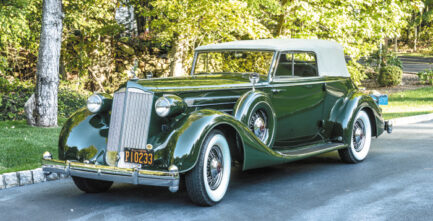
Packard’s accounting during these years did not break out costs and revenue by model line and did not allocate overhead costs by model line. So, it is impossible to know just how much money continuing the “Senior” lines after 1935 cost the company. That it was an enormous amount is beyond reasonable dispute.
After 1930, sales of the “Senior” lines reached the break even point only once – in 1933. After introduction of the One-Twenty, the “Senior” lines drained money from Packard’s profits on the lower priced models. For just the three years from 1935 through 1937, that totaled about $20 million. That is $20 million Packard didn’t put in the bank, in addition to approximately $20 million it lost before 1935 and in addition to perhaps as much as another $20 million lost producing the “Senior” Packards in 1938 through 1941.
The “Senior” models may have drained $60 million from Packard in ten years.
Adjusted for inflation, that is $1.113 billion in 2019 dollars.
When looking for the real reason Packard died, this is the beginning of what became, in time, the end.
Though Alvin Macauley had been very quick to see the need for Packard to introduce a lower priced automobile, he seems to have been blind to the financial damage continuing production of the “Senior” models was doing to the company.
The disappearance of the market for handcrafted luxury automobiles costing $2,500.00 or more during the 1930’s is commonly attributed to the Depression. However, the depression simply accelerated a trend that had started in the 1920’s. Even before the Depression, that market was steadily shrinking as new production technology improved the quality and performance off mass-produced automobiles. Ford’s development of the River Rouge complex (as chronicled in a previous post) foreshadowed the path the entire industry would take. Automobiles priced at $2,500 or more held ten percent of the automobile market in the 1920’s. In 1932, they were 2% of the market. By 1937, this had been cut to 0.5% of the market. Most of Packard’s competition had been eliminated by then, so Packard competed only with Cadillac and Lincoln.
Macauley squandered the financial bonanza of the One-Twenty. As company President, Macauley concluded each year’s Annual Report to Shareholders with his personal remarks. Not once after introduction of the One-Twenty did he refer in those remarks to the “Senior” line Packards. Rather, his remarks uniformly focused on the increase in revenue resulting from Packard’s increasing sales of lower-priced automobiles.
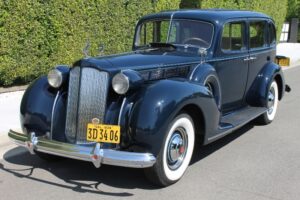
Packard’s decision to sustain production of the “Senior” cars during the last half of the 1930’s was almost quixotic. Lincoln continued the Model K because Edsel Ford wanted it to – and had the Model A and B Fords to finance it. Cadillac continued to produce twelve and sixteen-cylinder automobiles because General Motors also could afford to lose money for prestige, and because it had the “companion” LaSalle to provide Cadillac dealers with sales. Packard lacked the financial strength of Ford and General Motors that allowed those companies to indulge in huge losses for corporate prestige.
Macauley saved Packard by introducing the One Twenty.
He set the stage for its failure by continuing the “Senior” models afterward.
The Japanese Bomb Packard
In April of 1941, Packard introduced the Clipper.
By then, Packard was a changed company, run by the people Macauley had brought in to produce the One-Twenty. Max Gilman was now company president, chosen by Macauley. Gilman knew a new model would be needed to maintain sales. To style it, he went outside of the company to hire Howard “Dutch” Darin. This was not a totally new car. It was to be built on the One-Twenty’s chassis and use the same engine, but with a new front suspension and an entirely new, completely modern appearance.
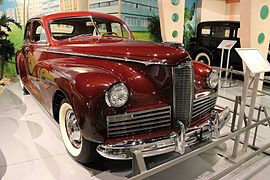
The Clipper was a hit. No – it was a home run. Packard had introduced a newly styled automobile that appeared far more modern than its competition. Packard sold 16,000 Clippers in 1941. It could have sold more, but – at Macauley’s insistence and over strong opposition within the company – Packard had subcontracted production of Clipper bodies to an outside manufacturer, the Briggs Manufacturing Company. Briggs couldn’t meet demand. It was August before production was able to provide dealers with adequate inventory.
1942 would have been a bonanza for Clipper sales.
Then the Japanese bombed Pearl Harbor.
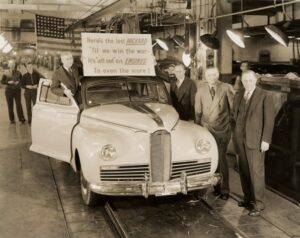
Packard went to war, along with the rest of the automobile industry, when it ended production in February of 1942. During the War, it produced engines for PT boats and the Merlin engines used in the P-51 Mustang, as well as in the British Mosquito, Lancaster, Warhawk, and Hurricane. (Packard had been solicited in 1940 to build the Merlin for the British under license from Rolls-Royce because only Packard was deemed capable of producing engines in quantity to the tolerances required for the Merlin.)
Though these wartime products were of Packard quality, the profits were ephemeral. Packard production during World War Two was rewarded with a profit of 1.2%, dictated by the government contracts and imposition of an excess profits tax on industry. Though Packard management avoided debt and maintained cash reserves, the company’s working capital declined during the war years from $46 million to $35 million.
World War Two cost Packard dearly. Without the War, Packard could have used profits from the Clipper to rebuild its finances in the years following 1941`. Packard had finally begun moving the “Senior” models to the One-Twenty’s chassis in 1938 and 1939, in the process dropping the Twelve and replacing the Super Eight with the 160 and 180. Further melding these models into the mass-produced lines would have removed an enormous drain on Packard’s profits. Coupling that with the jump the Clipper gave Packard over its competition provided Packard with a golden opportunity for profit in the years to follow 1941.
Those opportunities were sunk on December 7, 1941, along with the Pacific Fleet.
The Bathtub

Packard fans all know the “bathtub,” the models Packard introduced in 1948 and continued in production through 1951 that looked like a bathtub upside down. Today, they are commonly regarded as ugly. They are also blamed with starting the nails in Packard’s corporate coffin. They were designed by Alvan Macauley’s son, Edward, based on a concept car he had designed during the war, the Phantom. The Phantom started life as a shortened two-door Clipper. It evolved during the war years into the bulbous design that was faithfully copied by Packard for the 1948 line.
As with prior significant events in Packard history, the introduction of the “bathtub” Packards and their failure in the post-War new car market centers on Alvan Macauley. Macauley had controlled Packard from the 1920’s, first as President and then, after 1939 and until 1948, as Chairman of the Board of Directors. His dominance of Packard was absolute. The Board members were completely loyal to him.
In the years before World War Two, the path Macauley had chosen for Packard was copied by its competitors, Lincoln and Cadillac. In 1937, though still producing the Model K, Lincoln introduced the Zephyr, a mass-produced automobile priced far below previous Lincoln products. In 1941, General Motors dropped the LaSalle line that had been sold by Cadillac dealers. In its place, GM introduced a new Cadillac model 61 in the same price range LaSalle had occupied. Like Packard, Lincoln and Cadillac were phasing out their handcrafted models, moving to shift their brands’ prestige to mass-produced quality automobiles.
The 1941 Clipper was priced at $1,420.00 – above the One-Twenty at $1,291.0 and below the functional replacements for the “senior” line, the 160 and 180, with the 160 starting at $1,795.00. This put the Clipper in the price range that that eventually became, after World War Two, the lower end of the luxury car market – the market that eventually would be dominated by the Cadillac deVille. Cadillac, like Packard, had dropped its handcrafted models, the twelve and sixteen-cylinder powered cars, in favor of eight-cylinder models priced competitively with the Packard 160 and 180. Though Packard still offered the 115C priced below the One-Twenty, the introduction of the Clipper was Packard’s claim to its share of the evolving market for modern luxury automobiles.
An unexpected event turned out to handicap Packard’s ability to capitalize after the War on the market it has begun to create with the Clipper.
On January 22, 1942, Max Gilman, the President of Packard, was in an automobile accident on Woodward Avenue in Detroit. He and his passenger were both injured and hospitalized. The problem was that his passenger was the wife of another Packard executive and that Alvan Macauley’s moral compass was offended by this “scandal.” From a present-day perspective, this seems a bit too Puritan. In the 1970’s, the arrest of Henry Ford II for drunk driving with a woman not his wife in the car caused a public stir, but more from curiosity than moral opprobrium. (Ford’s famous response to the press was “never complain, never explain.”) No one suggested he should leave the Ford Motor Company. But this was another time, and Macauley considered Gilman’s conduct immoral. Though the board had decided that Gilman should stay, Macauley acted unilaterally and fired Gilman.
Firing Gilman deprived Packard of a president who had demonstrated with the Clipper that he understood the market for the Packard brand and could give that market a car that set design trends, rather than following them. It also meant finding a replacement for Gilman – not in a rational and developed process, but in a hurry. Macauley chose George Christopher. It was a bad choice.
Christopher was a production man. He had no sense of the market. After the War, as Packard converted back to producing automobiles, Christopher promised Packard shareholders that the company would produce 100,000 automobiles in 1946, a number it did not reach until 1948. He focused on producing low priced cars that he believed could sell in volume, oblivious to a market so starved for new cars that Packard’s dealers easily could have sold that same volume in the higher priced Packard models, had only Christopher elected to emphasize their production. As it was, Christopher’s decisions meant most of Packard’s sales were not in the luxury market increasingly being defined by Cadillac, but instead were in lower priced cars. Christopher even produced a Packard taxi cab model.
Christopher, in short, had no idea of what he was supposed to be selling. He’d promised volume production. To him, that meant selling cars cheaply. It did not occur to him that he was facing a new era in which a booming economy would birth a large market for luxury automobiles very different than those represented by the old Super Eight and Twelve models.
Christopher was also hamstrung by events beyond his control. It took much longer than he had anticipated to resume automobile production after the War. He needed to build a new assembly line. Steel was in short supply after the war, partly due to union strikes against steel producers. Packard suppliers were also hit with strikes, leaving Packard without the parts needed to produce new cars. Now that the Clipper was the only model with which Packard could resume production, Macauley had elected to stay with Briggs as the supplier of all Packard bodies. Briggs had convinced Macauley that it could produce bodies more cheaply than could Packard. The decision eliminated Packard’s ability to produce bodies in-house, making it totally dependent on Briggs. Briggs had a lengthy and confrontational history of labor problems. Supplier issues, along with strikes against Briggs, kept Packard assembly lines motionless for 81 of the 90 days in the first quarter of 1946.
Packard did realize it needed a new model. It committed $20 million to expanding post-War production and budgeted $8.5 million for tooling for the new model. But “new” to Packard meant something entirely different than “new” meant to General Motors.
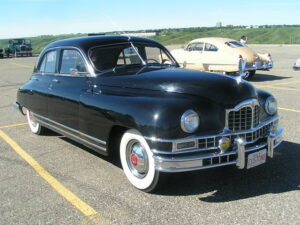
Though there were no automobiles in production during most of World War Two, those who would be responsible for new car styling after the war were actively experimenting with design ideas during the War. Prominent among these ideas were streamlined designs that were very rounded in shape, often covering much of the wheels. Known as “envelope” bodies because they carried the body line from front to back with no break for a separate rear fender, even General Motors designers considered this style for Cadillac. In the end, Harley Earl rejected this approach and introduced an entirely new Cadillac design for 1948, one that featured a signature tail lamp that would evolve during the ensuing decade into tail fins and showed a distinct hip at the rear quarter panel. In 1949, Cadillac introduced a modern, high-compression V-8 as standard equipment across the line. General Motors had already introduced a fully automatic transmission in 1939.
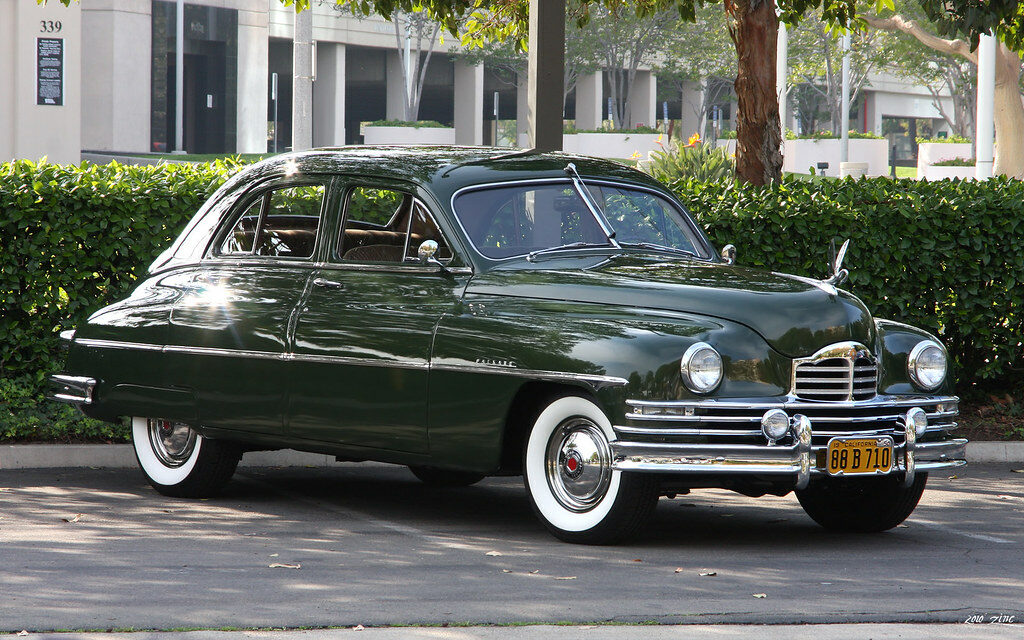
Packard chose to revise the Clipper and stay with the same straight eight-cylinder engine it had been building before the War and to continue production of six-cylinder models, as well. Though Packard’s design staff, headed by John Reinhart, favored a design that would streamline the existing Clipper design, Christopher was influenced by the envelope school of design and wanted the bulbous design based on Edward Macauley’s Phantom. (Reinhardt would design the “bathtub’s” replacement, introduced in 1951 )
The thought process at Packard in the years leading to the 1948 introduction of the “bathtub” models, known as the 22nd Series, show management that was consistently risk averse. Christopher’s emphasis on production goals for lower-priced models was a form of denial that avoided addressing the need for developing features, including V-8 engines and an automatic transmission, that would be beyond Packard’s resources without either raising significant new capital or incurring substantial debt. Immediately after the War, Christopher had obtained for Packard a $30 million line of credit to finance reconverting the factories to automobile production. There is no indication that Christopher or the Board of Directors ever considered incurring debt to develop truly new models.
Instead, Christopher chose to hoard the company’s cash.
Though George Christopher presided over these decisions, Alvan Macauley – still Chairman of the Board until his resignation in 1948 – was the person truly responsible for them.. The decisions may have been made by others, but Alvan Macauley remained the man in charge. Those decisions could not have been reached without his approval, tacit or actual.
Chriopher kept the “bathtub” in production for 1950 and the bottom dropped out of Packard sales.
Packard would never again be a significant factor in the luxury automobile market.
Epilogue – The Real Reason Packard Died
I have a soft spot for Packard. Their slogan was “Ask the Man Who Owns One.” My father owned four and his last Packard was also the last true Packard – a 1956 Patrician, bought new with every option except air conditioning. I still have a set of keys to it on my desk.
With the benefit of that perfect vision always provided by hindsight and putting sentiment aside, responsibility for the failure of Packard ultimately rests with decisions made by Alvan Macauley.
The real reason Packard died starts with the decision to continue production of the “Senior” models. No rational businessman pursues production of an expensive product for a shrinking market that cannot make a profit, eroding the capital of the business with every product sold. Macauley, however, did just that – and quite deliberately. Decisions after World War Two were designed to ‘play it safe’ by outsourcing body building and not investing in a truly new model with modern features. Having squandered vast sums on the “Senior” models, the mentality of Packard management had became risk-averse. They failed to see that the greater risk lay in allowing opportunity to pass them by. Had they had the financial cushion timely termination of the “Senior” models could have created, management may have seen the post-War market for what it truly was: the largest market for luxury automobiles in history.
The real reason Packard died is not that the One-Twenty saved the company at the cost of Packard’s prestige, and thereby damaged the brand in the marketplace. The real reason Packard died is that Packard’s management squandered the lifeline the One Twenty had provided.
For further information about Packard’s post-War fortunes and its ultimate demise, see also our additional post Pat Foster and the Myths of Packard’s Demise.
Sources: Packard annual reports are available at packardinfo.com.

